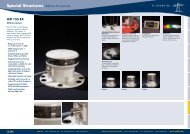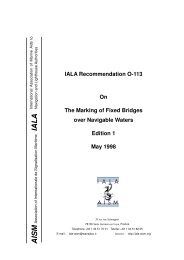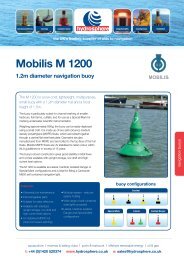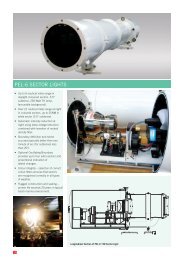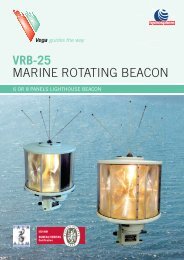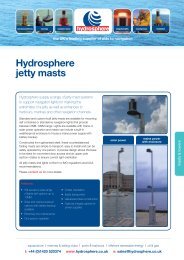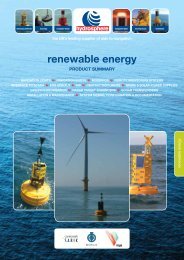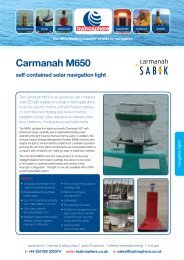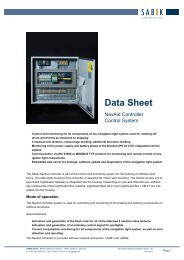Hydrosphere UK Ltd Complete Products & Services Catalogue
Hydrosphere UK Ltd Complete Products & Services Catalogue
Hydrosphere UK Ltd Complete Products & Services Catalogue
You also want an ePaper? Increase the reach of your titles
YUMPU automatically turns print PDFs into web optimized ePapers that Google loves.
5. Oscillating Boundary Option: Yes or No<br />
This option is used in critical applications<br />
where early warning of deviation from a<br />
central line is required. On solar-powered<br />
sites it may be less attractive because<br />
long lamp on-periods are required for its<br />
effective operation. Refer to Oscillating<br />
Boundary.<br />
6. Determine Individual Sector Angles<br />
Each sector light is individually<br />
confi gured for its end use. For most<br />
applications red, white and green colours<br />
are chosen. The sector sizes are always<br />
specifi ed reading from left to right when<br />
looking towards the light from on board<br />
the vessel.<br />
7. Check Vertical Divergence<br />
Sketch a vertical profi le through the light<br />
and viewing area. Check that mariners<br />
on highest and lowest vessels at closest<br />
and most distant points all fall within the<br />
vertical divergence of the light.<br />
Dixon Cove (16°20’N, 86°29’W) – Roatan is one of the Honduras Bay Islands in the Caribbean Sea.<br />
A PEL-3-3.5D, solar powered with on-demand switching via VHF marine radio has been deployed in<br />
the Dixon Cove Harbour of Roatan Island.<br />
Night Step PEL-3 Volts PEL-6 Volts Average Current Night Intensity<br />
1 12.0 24.0 100% 100%<br />
2 11.0 22.0 88% 75%<br />
3 10.3 20.5 80% 60%<br />
4 9.0 18.0 65% 40%<br />
5 7.2 14.4 47% 20%<br />
6 6.0 12.0 36% 10%<br />
PEL-6 lights have the night intensity<br />
further reduced by insertion of a Night<br />
Filter with a transmission between 5%<br />
and 50%. Where lamp voltage reduction<br />
and a night fi lter are used together, the<br />
fi nal transmission is the product of the<br />
two values.<br />
Example:<br />
• 60% of peak intensity from lamp<br />
voltage reduction<br />
• 5% transmission through night filter<br />
(when inserted)<br />
• Night intensity = 60% x 5% = 3%<br />
of day intensity<br />
Specifi cation Sequence<br />
1. Night Only or Day & Night<br />
The fi rst decision is whether a night-only<br />
signal is required, or a day and night<br />
signal. Generally, use a PEL-3 for night<br />
only, or a PEL-6 for day & night. For very<br />
short distances a PEL-3 can be used in<br />
daylight, but night dimming is only by<br />
voltage reduction.<br />
2. Determine Required Intensity<br />
This depends on the range required<br />
and the conditions under which viewing<br />
occurs (transmissivity of atmosphere,<br />
level of background lighting). Use IALA<br />
Recommendations for guidance, or<br />
contact Vega for assistance.<br />
3. Choose Total Subtense<br />
There is a tradeoff between subtense and<br />
intensity – the greater the subtense the<br />
less the intensity (for a given lamp). Refer<br />
to PEL-3 and PEL-6 tables for intensities.<br />
4. Choose Lamp Size<br />
For the PEL-3 the maximum size lamp<br />
is 100 Watts. The M28 100W lamp gives<br />
best performance, but smaller lamps are<br />
adequate for lower intensities. Refer to<br />
table of lamp performance for PEL-3<br />
Lights. For the PEL-6 the M36 250 Watt<br />
lamp (24 Volts) is standard, but smaller<br />
lamps can be accommodated.<br />
8. Specify Flash Character<br />
Each PEL Sector Light uses a CALC-2001<br />
controller, which has 256 fl ash codes.<br />
Certain lamps have minimum on and<br />
off-times. For Oscillating Boundary (OB)<br />
use a fi xed character, or one with at least<br />
8 seconds on-time to allow at least two<br />
full OB cycles.<br />
9. Specify Night Intensity Reduction<br />
(if applicable)<br />
When the PEL Light is used day and<br />
night, intensity reduction is required at<br />
night. Night intensity is a percentage of<br />
day intensity. Lamp voltage reduction<br />
value can be adjusted in the fi eld, but<br />
changing the Night Filter transmission<br />
requires a new fi lter.<br />
10. Reduced Intensity in White Sector:<br />
Yes or No<br />
Intensity in the white sector can be<br />
reduced to 50% using a ND fi lter to<br />
match the apparent intensities in the<br />
coloured sectors.<br />
11. Anti-Refl ection Coatings (PEL-3)<br />
These give up to 35% extra intensity in<br />
critical applications.<br />
12. Connections to Other Devices<br />
Synchronisation to other lights,<br />
monitoring interfaces, remote on-off<br />
or intensity control.<br />
6



